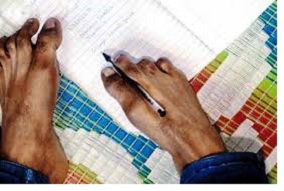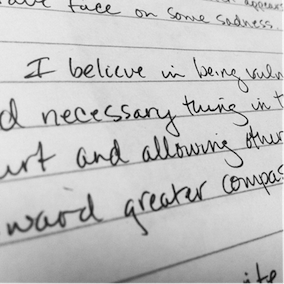
They wouldn’t need much, would they? A few small fish, an arrangement of figs. A little paper. A handful of words. —Carole Maso [i]
In her poem “The Invitation,” Oriah Mountain Dreamer reminds us:
It doesn’t interest me
what you do for a living.
I want to know
what you ache for
and if you dare to dream
of meeting your heart’s longing [ii]
Longing can be defined as “yearning desire.” Desire is a strong feeling of wanting or wishing to possess something. Needs are essentials or very important for survival. You need food, water, and sleep, but your desires can be much broader. In many cases, our wildest desires are extinguished when we become adults—as we’re taught the value of practicality. But as writers, allowing ourselves to acknowledge unrealistic desires can be fruitful for our work. Maybe you want to write the next Pulitzer-prize winner, Surrealist manifesto, or bestselling young adult novel. What’s holding you back from allowing yourself to acknowledge your desires? Writers have to want and desire to write, just as doctors have a want and desire to help people and patients desire to retain their freedom and well being. Dutch philosopher, Erasmus says, “The desire to write grows with writing.”
Ask yourself:
What is it that you want to write?
What is it that you need to write?
Do you know the difference? [iii]
How does this drive you?
You may have difficulty sensing the nuanced differences between what you want, need, and desire to write, but recognizing those subtleties can lead to more precise writing. If you have no desire to write fiction, but rather a hybrid memoir or essay, go for it. In an interview with Carole Maso, Brian Evenson (Rain Taxi, December 3, 1997) discusses the connection Maso has in her work between language and desire, the two intermingling in often-unpredictable ways. She reflects on an essay she wrote called, “Except Joy” (in Review of Contemporary Fiction, Fall 1998) “on the notions of language as heat and light, motion and stillness, a vibrant living thing capable of containing great emotion. Also, fluid, shifting, elusive, fugitive, and ultimately outside one’s grasp. Shapes the silence and darkness keep taking back. Bodies that make fragile, amorphous, beautiful shapes for a moment and then are gone.”
Remember Maslow’s Hierarchy of Needs? It’s a simple tool used to illustrate the progression from basic to complex needs:
1) Physiologic needs such as air, food, water, shelter, sanitation, touch.
2) Safety needs such as security of body, employment, resources, morality, family, health, and property.
3) Love and belonging needs such as sexual intimacy and relatedness with family and friends.
4) Esteem needs such as confidence and respect of others.
Once basic needs are met, people seek emotional evolution. At the top of the hierarchy is self-actualization, which, according to Maslow, is “the process of growing and developing as a person to achieve individual potential.” Self-actualization includes creativity, spontaneity, and lack of prejudice.
Make a list of your writing needs and desires. Let yourself go—don’t be afraid of seeming unrealistic. Let yourself think about publishing in Best American Essays or writing a feature article for a national or international publication. Categorize your list into your creative life’s emotional, physical, spiritual, and mental needs. Think about why each listed item is important to you. What basic needs and wants are most vital to your writing? How have your needs and desires been fulfilled by writing? What do you notice happens in your creative life when you get what you want?
By recognizing our own desires, and how they are constantly changing and evolving, we become more aware of what motivates our decisions. Laura King, professor of psychology at the University of Missouri at Columbia, notes, “Writing about topics that allow us to learn about our own needs and desires may be a way to harness the positive effects of writing.” [iv]
Every character in a story wants, needs, or desires something. Unconscious and conscious desires drive the creation of intriguing characters. Novelist Ryan Harty suggests that beginning writers use the following recipe to create more complex characters: two desires, two fears, one secret, eight very important things. [v] What does your writing or a character in your writing most want, need, or desire? How can you write those wants and desires?
How we need another soul to cling to, another body to keep us warm. To rest and trust; to give your soul in confidence: I need this, I need someone to pour myself into. —Sylvia Plath, The Unabridged Journals of Sylvia Plath
Consider you and your characters in terms of Maslow’s hierarchy. How do we write hunger/thirst? How do we write greed? How do we tell the difference? How do we make that difference known when we’re writing characters?
Too often we recognize desire in others—fictional characters included—and fail to turn the microscope on ourselves. Understanding your needs and desires, and the difference between them, will allow you to progress through Maslow’s hierarchy and to create more meaningful conflicts for your characters. You’ll benefit personally from becoming more aware of your longings and desires in your writing life—and your readers will sense the difference as well.
That is the beauty of all literature. You discover that your longings are universal longings… —F. Scott Fitzgerald
[i] Maso, C. (1994). The American woman in the Chinese hat.
[ii] Dreamer, O. M. (1999). The Invitation. Verse 1.
[iii] Elizabeth Hunter. Retrieved May 28, 2014 from http://elizabethhunterwrites.com/about/for-writers/about-writing/wantneeddesire/
[iv] King, L. (2002). Gain without pain, expressive writing and self-regulation. In Lepore, Stephen J. (Ed). Smyth, Joshua, M. (Ed). The writing cure: How expressive writing promotes health and emotional well-being (pp. 119-134). Washington, D.C.; American Psychological Association, xii, 313 pp.
[v] Harty, R. (2011). Meet your protagonist! In Eggers, D. (Ed.). Don’t forget to write, for the secondary grades: 50 enthralling and effective writing lessons (pp. 101-102). San Francisco, CA: Jossey-Bass.
Debbie spent 30 years as a registered nurse. She became a certified applied poetry facilitator and journal-writing instructor in 2007. She is currently a student in the Johns Hopkins Science-Medical Writing program. Her publications have appeared in Journal of Poetry Therapy, Studies in Writing: Research on Writing Approaches in Mental Health, Women on Poetry: Tips on Writing, Teaching and Publishing by Successful Women, Statement CLAS Journal, The Journal of the Colorado Language Arts Society, and Red Earth Review.



 The only disability in life is a bad attitude.
The only disability in life is a bad attitude.
